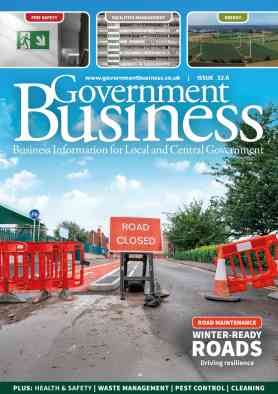
RISCAuthority Guidance
George Edwardes, technical director at the FPA introduces the RISC 501 - Fire Safety Assessment Test for External Cladding Systems.
Cladding system fires have been increasing globally, with the UK reporting the third most casualties per population since 1990. Combustible cladding systems are approved on high-rise buildings in the UK by the performance-based route to compliance, using the BS 8414 test method and BR 135 assessment criteria.
This test involves installing a representative cladding system on a 10 m high test rig and subjecting it to a large fire representing a room in flashover venting out a window and attacking the front face of the cladding system. However, serious questions have been raised regarding the appropriateness of the fuel source, test construction, construction detailing, assessment criteria, and availability of test results.
The FPA, through RISCAuthority, conducted a research project with the aim of enhancing the safety of tall buildings by preventing fire spread through external cladding systems. The project culminated in the development of RISC 501, a ‘fire safety assessment test for external cladding systems’. It is a large-scale fire test method and assessment method that is designed to be conducted alongside BS 8414 so that the results can confer compliance with both BR 135 and RISC 501.
Key findings:
Database of cladding fires
A database was populated with data from various fire tests of external cladding systems conducted according to the BS 8414 test method and evaluated against the BR 135 performance criteria, with the results compared to the fire performance of cladding systems in the real world. The primary objective was to generate data that would serve as a foundation for critically evaluating the BS 8414 test methodology by exploring the strategies and interpretations employed to meet the BR 135 criteria.
Construction detailing
The analysis identified several irregularities with the construction detailing between real buildings and the representative test setups. Unsurprisingly, all of these irregularities resulted in the test setup being better protected from fire ingress and fire spread than the real buildings.
During fire tests, the edges of the test rig would be sealed, preventing the natural ventilation seen on real buildings. This reduces the oxygen available for combustion and can have a significant impact on the growth of the fire.
There is a burn chamber at the bottom of the test rig, where the fuel load for the fire test is placed. The burn chamber opening was often overprotected using materials and methods that were not repeated on real buildings. This overprotection prevents fire from entering any cavities behind the cladding system and attacking the combustible insulation in a way that fire normally would through weaknesses like windows.
The most severe form of overprotection came from the overuse of cavity barriers.
Most systems contain cavity barriers and fire breaks to prevent fire spread through cladding systems and comply with Approved Document B. ‘Clever’ interpretation of the test rig allowed for the use of five horizontal cavity barriers per test, when only two or three would be used over the same space on a real building.
This will undoubtedly have a significant impact on the performance of the cladding system during a fire test.
Performance criteria
The BR 135 performance criteria specifies a maximum temperature limit that must be met during the first 15 minutes of the fire test. The number of combustible insulation products which would survive this 15-minute period before rapidly developing into a fully involved cladding fire is astounding. This gave the impression that they had been chemically engineered to last 15 minutes but no longer.
The scientific justification for this 15-minute assessment period has never been fully revealed and neither has the temperature limit, which is just over 600°C. It has often been argued that 500°C would be a more appropriate limit for judging the combustion of typical cladding materials.
Even if this assessment of a rate of fire spread of 15 minutes per floor had some relevance to life safety, it clearly has no relevance to property protection. There are many cladding systems on the market that are capable of preventing fire spread to multiple floors and there is no reason why this shouldn’t be the minimum requirement.
Notable differences
RISC 501 was developed to specify a test method and assessment criteria for the fire performance of external cladding systems and was designed to be conducted concurrently with BS 8414.
Some notable feature differences of RISC 501 include: additional design requirements affecting floor heights and cavity barrier locations; additional design requirements affecting detailing around the burn chamber opening and edges of the test rig; different sensor locations; different sensor criteria; additional gas sampling requirements; additional mechanical performance requirements; and additional material characterisation requirements.
Construction criteria
The test construction criteria now mandate that all systems must design against the same virtual building. The virtual building is not actually constructed on the test rig but exists to specify locations for floor heights and window openings. This ensures that all cladding systems tested are designed against the same building, allowing results to be comparable whilst preventing systems from being overprotected from fire spread by designing against an unrealistic building.
Temperature criteria
An impact assessment was conducted to identify the impactof lowering the temperature criteria and extending the measurement period. It was noted that with the current temperature sensor locations, many non-combustible systems would fail to meet stricter requirements (due to flame spread in the cavity). This suggests that the test would be too onerous with unrealistic performance requirements.
This was partly due to the close proximity between the temperature sensors and the flames from the burn chamber.
The temperature sensors were, therefore, moved further away from the fire, allowing the temperature criteria to be lowered and the measurement period to be extended to the full duration of the test.
The virtual building also specified a floor height between the peak flame temperature and the temperature sensor locations. This meant that a typical cladding system would place a cavity barrier between the test fire and the temperature sensors, allowing for an assessment of the cladding systems’ ability to prevent fire spread to multiple floors.
Miscellaneous criteria
During real cladding fires, it is regularly reported that fallen material has impeded firefighting operations, which will clearly have an impact on both life safety and property protection. Mechanical performance criteria were therefore set based on the performance requirements for firefighting helmets.
Smoke toxicity is an emerging issue across the entire fire industry, so criteria were set for extracting and measuring gases from the rear of the cladding system. No performance criteria were set, as further research is required on the relationship between the concentration of toxic products produced by a cladding system and the potential concentration of toxic products in an adjacent room inside the building.
Material characterisation criteria
Products can differ between fire tests and real-world applications for a variety of reasons.
Continuous improvement: products are constantly being changed and improved to keep up with changes in the market. Minor changes do not constitute the need for re-evaluation of fire ratings. However, cumulative alterations can eventually amass into significant changes. Although significant changes should prompt re-testing, this step is not necessarily conducted.
Test specials: manufacturers could employ chemically enhanced products to deceive a fire test house. These enhanced products might be too expensive to mass produce, leading to cheaper, worse-performing products sold to market.
Insufficient test specification: the test standard might lack precise specifications, allowing a product used in a fire test to differ substantially from the real-world application, while still complying with the defined parameters.
To address the potential issue of manufacturers using superior performing products in fire tests, compared to those actually installed on buildings, a method for material characterisation was developed.
This method produces a representative ‘chemical fingerprint’ of the products tested using small scale tests designed to identify significant chemical variations between products submitted for testing and those supplied to market. This method employs microscale combustion calorimetry and infrared spectroscopy to establish a unique chemical fingerprint for each major component of a cladding system.
This approach was found to be capable of identifying new chemical substances, detect the absence of existing ones, assess changes in combustion properties, and quantify process reactions, such as the formation of isocyanurate rings.
Validation tests
Validation tests were conducted against the proposed RISC 501 method to compare the results of the predicted performance of cladding systems during the test, to their actual performance, with the aim of identifying: any physical impossibilities with the implementation of the prescribed test setup, including construction detailing and sensor locations; the test’s ability to identify flame spread through known combustible cladding systems; the test’s ability to identify a lack of flame spread through known non-combustible cladding systems; the test’s ability to identify mechanical failures; and the test’s ability to measure a significant difference in the smoke toxicity between a combustible and non-combustible system.
Ultimately, RISC 501 was found to clearly differentiate between systems which promoted fire spread and systems which did not. It offers a much clearer distinction than the BR 135 assessments, whilst also using stricter performance criteria.
Summary
In summary, RISCAuthority conducted a study to investigate critical issues related to cladding system fires and the fire testing of external cladding systems, particularly in the UK, where combustible cladding systems are approved for high-rise buildings. The findings from that research were used to develop the fire test and assessment method: known as RISC 501 – Fire Safety Assessment Test for External Cladding systems.
This article only covers some of the main changes, but there are a significant number of other changes mandated based on the extensive research project. The research behind this work will be shared with the British Standards Institute and the European Commission so that the findings can also aid the development of future British and European cladding test standards.
About the Author: George Edwardes, technical director at the FPA George is responsible for collaborating with stakeholders, and directing policy development and quality assurance. He also manages the Technical Steering Group, comprising the FPA’s technical experts. George holds a BEng (Hons) in Mechanical Engineering and is currently conducting an MSc by Research, focusing on fire safety assessment tests for external cladding systems.


